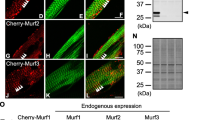Summary
A net of filaments of about 60 Å diameter, similar to actin filaments, is observed in cross striated muscle cells in the lymph heart of Rana temporaria L. The filaments form circular strands beneath the sarcolemma. They connect the Z-regions of myofibrils and make contact with the sarcoplasmic reticulum, specially where it is attached to the sarcolemmal invaginations (“enhapsis”). It is supposed that the filaments resist mechanical forces perpendicular to the myofibrils and keep cellular structures in the right place.
In relation to these filaments the Z-bridges (Garamvölgyi), Krauses Grundmembran, Ringbinden und leptomere myofibrils (Thoenes and Ruska) are discussed. It is concluded that muscle cells are capable to develop non contractile (filaments in the lymph heart) or contractile (Ringbinden) systems in response to forces acting perpendicular to the regular myofibrils.
Zusammenfassung
Die quergestreiften Muskelzellen im Lymphherzen von Rana temporaria werden von etwa 60 AE dicken Filamenten durchzogen, die den Aktinfilamenten ähnlich sind. Sie bilden ein Netzwerk, das unter dem Sarkolemma zirkulär verläuft und mit queren Zügen die Z-Streifen der Myofibrillen untereinander und mit der Zellmembran verbindet. Aktinfilamente der Myofibrillen strahlen in das Netzwerk ein. Die Filamente haben Beziehung zum Sarkoplasmaretikulum und seinen Anlagerungen (Enhapsen) an die sarkolemmalen Einstülpungen (T-System). Das tonofibrillenartige System dient vermutlich der Aufnahme von quer zu den Myofibrillen gerichteten Kräften, unterstützt so den Ablauf der gerichteten Kontraktion der Weichteilmuskulatur des Lymphherzens und erhält die Lage und Ordnung der intrazellulären Strukturen.
Im Zusammenhang mit den zytoplasmatischen Filamenten wird hingewiesen auf die sog. Z-Brücken (Garamvölgyi), die Krausesche Grundmembran, die Spiralbinden (Ringbinden) und die leptomeren Myofibrillen (Thoenes und Ruska), die zeigen, daß Muskelzellen passiv wirksame (Filamente im Lymphherzen) und aktiv wirksame (Ringbinden) Quersysteme zur Aufnahme bzw. Ausübung von quergerichteten Kräften auszubilden vermögen.
Similar content being viewed by others
Literatur
Athanasiou, D. J., u. P. Dziallas: Über hypolemmale Ringbinden im Reizleitungssystem des Schafsherzens. Z. Zellforsch. 43, 214–227 (1955).
Bergstrand, C. G.: Zur Morphologie der quergestreiften Ringbinden. Z. mikr.-anat. Forsch. 44, 45–55 (1938).
Caesar, R., G. A. Edwards, and H. Ruska: Electron microscopy of the impuls conducting system of the sheep heart. Z. Zellforsch. 48, 698–719 (1958).
Day, J. B., R.-H. Rech, and J. S. Robb: Pharmacological and microelectrode studies on the frog lymph heart. J. cell. comp. Physiol. 62, 33–41 (1963).
Ernst, E.: Die Muskeltätigkeit. Budapest: Akadémiai Kiadó 1958.
Fischman, D. A.: An electron microscope study of myofibril formation in embryonic chick skeletal muscle. J. Cell Biol. 32, 557–575 (1967).
Garamvölgyi, N.: Interfibrilläre Z-Verbindungen im quergestreiften Muskel. Acta physiol. Acad. Sci. hung. 22, 235–241 (1962).
—: Observations préliminaires sur la structure de la strie Z dans le muscle alaire de l'abeille. J. Microscopie 2, 107–112 (1963).
—: The arrangement of the myofilaments in the insect flight muscle. II J. Ultrastruct. Res. 13, 425–434 (1965).
Gaupp, E.: Anatomie des Frosches. 2. Abt.: Lehre vom Nerven- und Gefäßsystem. 2. Aufl. Kapitel „Die Lymphherzen“, S. 438–448. Braunschweig: Vieweg & Sohn 1899.
Goerttler, K.: Die Gestaltungsfähigkeit des quergestreiften Muskelgewebes unter dem Einfluß experimentell abgeänderter Funktionsbedingungen. Verh. Dtsch. Orthop. Ges. 30. Kongr. 1935, S. 34–40.
—: Die Ordnung, Histologie und Histogenese der quergestreiften Muskulatur im menschlichen Stimmband. Z. Anat. Entwickl.-Gesch. 115, 352–401 (1950).
Graf, P.: Eigenartige Strukturverhältnisse in der Muskulatur der menschlichen Uvula. Z. Anat. Entwickl.-Gesch. 114, 399–419 (1949).
Häggqvist, G.: Skeletmuskelgewebe. In: Handbuch der mikroskopischen Anatomie des Menschen, Bd. II/3, S. 105–183. Berlin: Springer 1931.
Hammersen, F.: Das Muskelgefüge in der Pharynxwand von Hirudo medicinalis und Haemopsis sanguisuga. Z. Zellforsch. 60, 797–814 (1963).
Heidenhain, M.: Über progressive Veränderungen der Muskulatur bei Myotonia atrophica. Beitr. path. Anat. 64, 198–225 (1918).
Hellman, T.: Lymphgefäße, Lymphknötchen und Lymphknoten. In: W. v. Möllendorff, Handbuch der mikroskopischen Anatomie des Menschen, VI. Bd, 1. Teil, S. 233–396. Berlin: Springer 1930.
Johnson, E. A., and J. R. Sommer: A strand of cardiac muscle. Its ultrastructure and the electrophysiological implications of its geometry. J. Cell Biol. 33, part 1, 103–129 (1967).
Lindner, E.: Die submikroskopische Morphologie des Herzmuskels. Z. Zellforsch. 45, 702–746 (1957).
- Submikroskopische Untersuchungen über die Herzentwicklung beim Hühnchen. Verh. Anat. Ges. 54. Verslg, Freiburg i. Br. S. 305–317. 1957.
Malan, E.: Etude d'histologie comparée sur quelques modifications particulières des fibres du tensor tympani dues à la sénescence. Arch. Biol. (Liège) 45, 355–375 (1934).
Müller, Joh.: Über die Existenz von vier getrennten, regelmäßig pulsierenden Herzen, welche mit dem lymphatischen System in Verbindung stehen, bei einigen Amphibien. Müllers' Archiv f. Anat. Physiol. u. wiss. Medizin, Jahrg. 1834, 296–300 (1834).
Priestley, J.: An account of the anatomy and physiology of batrachian lymph-hearts. J. Physiol. (Lond.) 1, 1–18 (1878/9).
—: Contributions to the physiology of batrachian lymph-hearts. J. Physiol. (Lond.) 1, 19–38 (1878/9).
Ruska, H., and G. A. Edwards: A new cytoplasmic pattern in striated muscle fibers and its possible relation to growth. Growth 21, 73–88 (1957).
Schwarz, M.: Über das Vorkommen quergestreifter Ringbinden bei den Augenmuskeln. Z. Anat. Entwickl.-Gesch. 75, 361–388 (1925).
Thoenes, W., u. H. Ruska: Über „leptomere Myofibrillen“ in der Herzmuskelzelle. Z. Zellforsch. 51, 560–570 (1960).
Waldeyer, W.: Anatomische und physiologische Untersuchungen über die Lymphherzen der Frösche. Z. ration. Med. 21, 105–124 (1864).
Author information
Authors and Affiliations
Additional information
Herrn Prof. Dr. med. Kurt Goerttler zum 70, Geburtstag gewidmet.
Die Untersuchungen wurden mit dankenswerter Unterstützung durch die Deutsche Forschungsgemeinschaft durchgeführt.
Rights and permissions
About this article
Cite this article
Lindner, E., Schaumburg, G. Zytoplasmatische Filamente in den quergestreiften Muskelzellen des kaudalen Lymphherzens von Rana temporaria L.. Zeitschrift für Zellforschung 84, 549–562 (1967). https://doi.org/10.1007/BF00320868
Received:
Issue Date:
DOI: https://doi.org/10.1007/BF00320868




